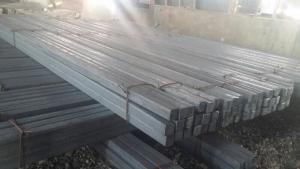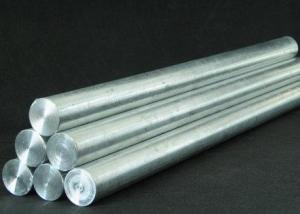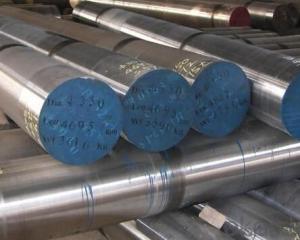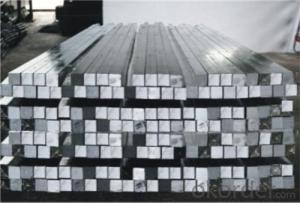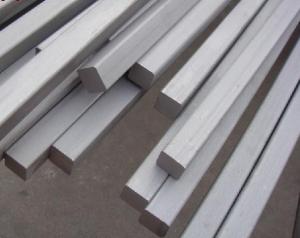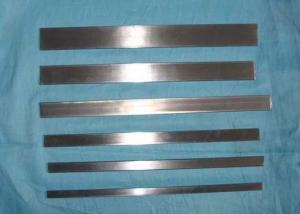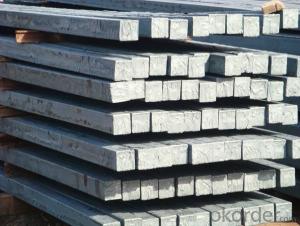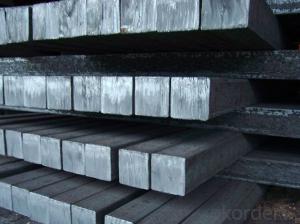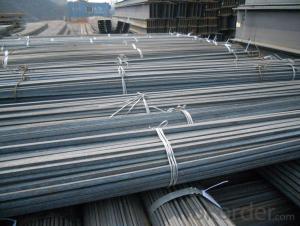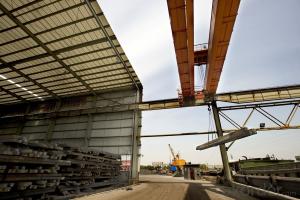Steel Square Bar With Chemical Element Boro
- Loading Port:
- China main port
- Payment Terms:
- TT OR LC
- Min Order Qty:
- 25 m.t.
- Supply Capability:
- 10000 m.t./month
OKorder Service Pledge
OKorder Financial Service
You Might Also Like
Product Description
There are two types of Square Bar, one is hot rolled square bar and other one is cold drawn square bar. Our principal products is hot rolled square bar. We dedicate to products with material Q195 and Q235. We offer products with high quality and low price.
Specifications
-Standard: GB,
-Grade: Q195/Q235 or equivalent.
-Chemical Composition:
Standard | Grade | Element (%) | ||||
C | Mn | S | P | Si | ||
GB | Q195 | 0.06~0.12 | 0.25~0.50 | ≤0.050 | ≤0.045 | ≤0.30 |
GB | Q235B | 0.12~0.20 | 0.30~0.70 | ≤0.045 | ≤0.045 | ≤0.30 |
-Mechanical Properties:
Mechanical Properties | Grade | Steel diameter(mm) | |||
≤16 | 16~40 | 40~60 | 60~100 | ||
Yield Point Δs/MPa | Q195 | ≥195 | ≥185 | - | - |
Q235 | 235 | 225 | 215 | 205 | |
Tensile Strength | Q195 | 315~390 | |||
Q235 | 375~500 | ||||
Elongation δ5% | Q195 | ≥33 | ≥32 | - | - |
Q235 | 26 | 25 | 24 | 23 | |
Measures (Big measures):
(Section of Hot-rolled Square Steel Bar)
-Length of a side and Theoretical weight of Square Bar (Big measures).
Length of a side(mm) | Theoretical weight(kg/m) | Length of a side(mm) | Theoretical weight(kg/m) |
53 | 22.05 | 80 | 50.24 |
56 | 24.61 | 85 | 56.72 |
60 | 28.26 | 90 | 63.59 |
63 | 31.16 | 95 | 70.85 |
70 | 38.49 | 100 | 78.50 |
75 | 44.16 |
Notes:
1, The theoretical weights in the list, base on the density of 7.85 g/cm3.
2, Formula for theoretical weight of Square bar: a(length of a side) * a * 0.00785
3, The numbers with *mean that they are not regular or we don’t offer them.
-Regular length of Square Bar:
Steel | Length of a side (mm) | Length of steel (m) |
Normal steel | < 25 | 4~10 |
> 25 | 3~9 | |
Steel of high quality | All measure | 2~6 |
Tool steel >75 | 1~6 |
Usage/Applications
-The Square Steel is normally used as structure steel.
-Row material for other structure steel like steel angles, channels, I-beams, H-beams, etc…
-Row material for steel pipes.
Packaging & Delivery
-Packing Detail:
1, The products can be packed in bundles by steel wires.
2, The weight of each bundle no exceed normally 3 tons.
-Marks: We make tag marks and color marks for each bundle. The tag marks with white background and red company log will be tied up to each bundle. The information is usually including basic information of company and products like product name, specification, etc...and other information required by customers. As for color marks, we will paint both ends of each bundles to make sure that it will be more convenient for customers to distinguish theme from other products.
-Delivery Detail: 30~45 working days after receive buyer’s T.T. or L/C.
Payment:
-Invoicing on theoretical weight or actual weight as customer’s request.
-FOB, CFR or CIF.
-Regular terms of payment:
1, 30% payment in advance, the remaining balance (70% payment) against the copy of B/L.
2, 30% payment in advance, the remaining balance (70% L/C) against the copy of B/L.
3, Negotiable.
-The payment terms will be written in contraction detailed.
- Q: Are there any specialty steel squares available for specific tasks?
- Yes, there are specialty steel squares available for specific tasks. Steel squares are versatile tools used in various industries such as carpentry, metalworking, and engineering. While standard steel squares can handle most tasks, there are specialized versions designed to meet specific requirements. For instance, in woodworking, there are specialty steel squares called rafter squares or carpenter's squares. These squares have additional features like tables or scales that aid in measuring angles and making complex cuts for rafters, stairs, and other applications. In metalworking, there are steel squares specifically designed for welding and fabrication tasks. These squares often have heat-resistant coatings or materials to withstand the high temperatures associated with welding. They may also have precise measurements and markings to ensure accurate layout and alignment. In engineering and machining, precision steel squares are commonly used. These squares are made with high accuracy and tight tolerances to ensure precise measurements and alignment. They are often used for setting up machinery, checking angles, and verifying perpendicularity. Furthermore, some specialty steel squares are designed for specific trades or industries. For example, there are masonry squares made from steel with rust-resistant coatings, specifically for bricklaying and other masonry tasks. Similarly, there are roofing squares with angled scales and markings for roofers to measure and cut accurately. Overall, specialty steel squares cater to the specific needs of different tasks and industries. Whether it's woodworking, metalworking, engineering, or other trades, there is likely a specialized steel square available to enhance precision, accuracy, and efficiency in those particular applications.
- Q: How do you maintain and clean a steel square?
- To maintain and clean a steel square, you can follow these simple steps: 1. Start by wiping the square clean with a clean and dry cloth to remove any surface dirt or dust. 2. If there are any stubborn stains or spots on the steel square, you can use a mild detergent or dish soap mixed with water. Apply the soapy solution to the affected areas and gently scrub the square using a soft-bristle brush or sponge. 3. Rinse the square thoroughly with clean water to remove any soap residue. 4. After cleaning, dry the steel square with a clean cloth to prevent any water spots or rust from forming. 5. If you notice any signs of rust on the steel square, you can remove it by using a rust remover or a mixture of equal parts lemon juice and baking soda. Apply the solution to the rusty areas and let it sit for a few minutes before scrubbing it off gently. Rinse and dry the square thoroughly afterward. 6. To maintain the steel square's accuracy and prevent rust, it is recommended to apply a thin coat of oil or lubricant to the surface. This will help protect the steel from moisture and corrosion. You can use a light machine oil or even petroleum jelly for this purpose. 7. Store the steel square in a dry and clean place to avoid exposure to moisture or humid conditions, as this can lead to rust formation. By following these steps regularly, you can ensure that your steel square remains clean, rust-free, and in good working condition for a long time.
- Q: Can a steel square be used for checking the levelness of a surface?
- Typically, a steel square is not employed to verify the levelness of a surface. Commonly known as a carpenter's square or a try square, a steel square is mainly utilized in woodworking and construction to measure and mark right angles. It is not specifically engineered or adjusted to determine levelness. To assess the levelness of a surface, it is more suitable to use a level tool like a spirit level or a laser level. These tools are specifically designed to indicate if a surface is perfectly horizontal or vertical, using a bubble or laser line respectively.
- Q: Can a steel square be used for checking the squareness of a planer bed?
- No, a steel square cannot be used for checking the squareness of a planer bed.
- Q: How does a steel square assist in checking the alignment of power tools?
- A steel square assists in checking the alignment of power tools by providing a straight and accurate reference edge or surface. It can be used to ensure that the tool's blade or fence is perfectly perpendicular or parallel to the reference edge, allowing for precise and accurate cuts or measurements.
- Q: Can a steel square be used for precision measuring?
- Precision measuring can be done with a steel square. A steel square, also referred to as a combination square, is a versatile measuring tool commonly used in woodworking and metalworking. It consists of a steel blade and a steel head that can be adjusted and locked at different angles to accurately measure and mark materials. Steel squares are designed to be precise and dependable, featuring clear markings and accurate measurements. They can be used for various measurements, including determining right angles, measuring and marking 45-degree angles, checking surface flatness, and transferring measurements. The steel construction ensures durability and stability, making it suitable for precise measurements over extended periods. Nevertheless, it's worth noting that while steel squares offer precise measurements, they do have limitations. They may not be suitable for measuring extremely small dimensions or highly sensitive measurements that require specialized tools like micrometers or calipers. However, for most general precision measuring tasks, a steel square can be a reliable and accurate tool.
- Q: What is a steel square?
- A steel square is a versatile measuring and layout tool used in carpentry and woodworking. It consists of a flat metal blade with different measurements and angles marked on each side. Its main purpose is to ensure accurate right angles and precise measurements during various construction tasks.
- Q: How do you use a steel square to measure the height of a window opening?
- To measure the height of a window opening using a steel square, adhere to the following guidelines: 1. Place the steel square vertically against one side of the window opening, ensuring it is flush against the side. 2. Securely hold the square in position, ensuring it is level and straight. 3. Observe the markings on the blade of the square, typically denoting measurements in inches and centimeters. 4. Commencing from the bottom of the window opening, align the edge of the square's blade with the lower edge of the opening. 5. Determine the measurement on the blade at the upper edge of the opening. This will provide the height of the window opening. 6. Document the measurement and repeat the procedure on the opposing side of the window opening to ensure precision. By utilizing a steel square, an accurate measurement of the window opening's height is obtained, eliminating the potential for inaccuracies that may arise when using measuring tapes or rulers.
- Q: How do you use a steel square to mark out 30-degree angles?
- To use a steel square to mark out 30-degree angles, you can follow these steps: 1. Start by placing the steel square on the surface or material you want to mark, ensuring that one of the legs of the square is aligned with a straight edge of the material. 2. Locate the 45-degree angle on the steel square. This is typically indicated by a 45-degree mark or notch on the inside corner of the square. 3. Once you have identified the 45-degree angle, align one leg of the square with the straight edge and position the other leg towards the direction you want to create a 30-degree angle. 4. Carefully pivot the square on the straight edge, keeping the 45-degree mark fixed on the edge. As you pivot, the other leg of the square will rotate, allowing you to mark out the 30-degree angle on your material. 5. Once you have achieved the desired angle, use a pencil or a marking tool to trace along the edge of the square or use the square as a guide to draw a line. Remember to always double-check your measurements and ensure that the square is securely positioned on the material to achieve accurate and precise markings.
- Q: What are some common techniques for using a steel square in cabinetry?
- A steel square, also known as a framing square or carpenter's square, is a versatile tool commonly used in cabinetry for measuring and marking angles, ensuring accurate cuts and joinery. Here are some common techniques for using a steel square in cabinetry: 1. Checking for squareness: One of the primary uses of a steel square is to check if a corner is perfectly square. Place the square against the inside corner, and if the edge aligns with the adjacent edge, the corner is square. This helps in ensuring all corners of the cabinets are at right angles. 2. Marking 45-degree cuts: The steel square has a 45-degree angle marked on its body. By aligning the square with the edge of the material, you can mark a precise 45-degree angle for mitered cuts, such as for trim or decorative elements on cabinet doors and panels. 3. Marking parallel lines: The long edge of a steel square is used for marking parallel lines. Simply align the square with the edge of the material and draw a line along the other edge of the square. This technique is helpful for marking shelf and cabinet bottom locations or ensuring parallel cuts. 4. Laying out cuts: The steel square is excellent for marking accurate lines for cuts. By aligning the square with the edge of the material, you can draw a line perpendicular or parallel to the edge. This helps in marking cuts for cabinet components like shelves, drawer dividers, and door frames. 5. Determining pitch and slope: A steel square can be used to determine the pitch or slope of a roof or any inclined surface. By placing the square on the surface, you can read the pitch or slope degree based on the markings on the square. 6. Measuring and transferring dimensions: The steel square can also be used as a ruler for measuring and transferring dimensions. The body of the square usually has a scale on one or both edges, allowing you to measure and mark precise lengths or distances. Overall, a steel square is an indispensable tool in cabinetry, offering accuracy and versatility in measuring, marking, and verifying angles. Whether you're building cabinets from scratch or making precise modifications, incorporating these common techniques will help ensure your cabinetry projects are precise and well-crafted.
Send your message to us
Steel Square Bar With Chemical Element Boro
- Loading Port:
- China main port
- Payment Terms:
- TT OR LC
- Min Order Qty:
- 25 m.t.
- Supply Capability:
- 10000 m.t./month
OKorder Service Pledge
OKorder Financial Service
Similar products
Hot products
Hot Searches
Related keywords
